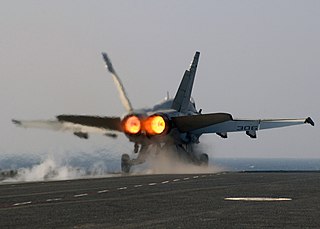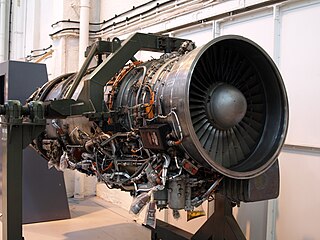
The turbofan or fanjet is a type of airbreathing jet engine that is widely used in aircraft propulsion. The word "turbofan" is a portmanteau of "turbine" and "fan": the turbo portion refers to a gas turbine engine which achieves mechanical energy from combustion, and the fan, a ducted fan that uses the mechanical energy from the gas turbine to force air rearwards. Thus, whereas all the air taken in by a turbojet passes through the combustion chamber and turbines, in a turbofan some of that air bypasses these components. A turbofan thus can be thought of as a turbojet being used to drive a ducted fan, with both of these contributing to the thrust.

An afterburner is an additional combustion component used on some jet engines, mostly those on military supersonic aircraft. Its purpose is to increase thrust, usually for supersonic flight, takeoff, and combat. Afterburning injects additional fuel into a combustor in the jet pipe behind the turbine, "reheating" the exhaust gas. Afterburning significantly increases thrust as an alternative to using a bigger engine with its attendant weight penalty, but at the cost of very high fuel consumption which limits its use to short periods. This aircraft application of reheat contrasts with the meaning and implementation of reheat applicable to gas turbines driving electrical generators and which reduces fuel consumption.

The Rolls-Royce Pegasus, formerly the Bristol Siddeley Pegasus, is a turbofan engine originally designed by Bristol Siddeley. It was manufactured by Rolls-Royce plc. The engine is not only able to power a jet aircraft forward, but also to direct thrust downwards via swivelling nozzles. Lightly loaded aircraft equipped with this engine can manoeuvre like a helicopter. In particular, they can perform vertical takeoffs and landings. In US service, the engine is designated F402.

The Turbo-Union RB199 is a turbofan jet engine designed and built in the early 1970s by Turbo-Union, a joint venture between Rolls-Royce, MTU and Aeritalia. The only production application was the Panavia Tornado.

The Pratt & Whitney F119, company designation PW5000, is an afterburning turbofan engine developed by Pratt & Whitney for the Lockheed Martin F-22 Raptor advanced tactical fighter.

The Pratt & Whitney J57 is an axial-flow turbojet engine developed by Pratt & Whitney in the early 1950s. The J57 was the first 10,000 lbf (45 kN) thrust class engine in the United States. The J57/JT3C was developed into the J52 turbojet, the J75/JT4A turbojet, the JT3D/TF33 turbofan, and the XT57 turboprop. The J57 and JT3C saw extensive use on fighter jets, jetliners, and bombers for many decades.

Bristol Siddeley Engines Ltd (BSEL) was a British aero engine manufacturer. The company was formed in 1959 by a merger of Bristol Aero-Engines Limited and Armstrong Siddeley Motors Limited. In 1961 the company was expanded by the purchase of the de Havilland Engine Company and the engine division of Blackburn Aircraft. Bristol Siddeley was purchased by Rolls-Royce Limited in 1966.

The Pratt & Whitney J52 is an axial-flow dual-spool turbojet engine originally designed for the United States Navy, in the 40 kN class. It powered the A-6 Intruder and the AGM-28 Hound Dog cruise missile. As of 2021 the engine was still in use in models of the A-4 Skyhawk.

The Bristol Siddeley Orpheus was a single-spool turbojet developed by Bristol Siddeley for various light fighter/trainer applications such as the Folland Gnat and the Fiat G.91. Later, the Orpheus formed the core of the first Bristol Pegasus vectored thrust turbofan used in the Harrier Jump Jet family.

The Bristol Orion aero engine was a two-shaft turboprop intended for use in later marks of the Bristol Britannia and the Canadair CL-44. Although the engine was built and underwent a development program, the BE.25 Orion project was cancelled in 1958 by the British Ministry of Supply in favour of the Rolls-Royce Tyne. In addition, interest in turboprop-powered aircraft was beginning to wane, because of the successful introduction of the Boeing 707 and Douglas DC-8 jetliners into airline service.

The Rolls-Royce RB.401 was a British two-spool business jet engine which Rolls-Royce started to develop in the mid-1970s as a replacement for the Viper. RB.401-06 prototype engines were already being manufactured when a decision to develop the higher thrust RB.401-07 was taken.

The Rolls-Royce/SNECMA M45H is an Anglo-French medium bypass ratio turbofan produced specifically for the twin-engined VFW-Fokker 614 aircraft in the early 1970s.
The Hawker Siddeley P.1154 was a planned supersonic vertical/short take-off and landing (V/STOL) fighter aircraft designed by Hawker Siddeley Aviation (HSA).

The General Electric YF120, internally designated as GE37, was a variable cycle afterburning turbofan engine designed by General Electric Aircraft Engines in the late 1980s/early 1990s for the United States Air Force's Advanced Tactical Fighter (ATF) program. Prototype engines were installed in the two competing technology demonstrator aircraft, the Lockheed YF-22 and Northrop YF-23.

The de Havilland Gyron Junior was a military turbojet engine design of the 1950s developed by the de Havilland Engine Company and later produced by Bristol Siddeley. The Gyron Junior was a scaled-down derivative of the de Havilland Gyron.

The Rolls-Royce/Snecma Olympus 593 was an Anglo-French turbojet with reheat (afterburners) which powered the supersonic airliner Concorde. It was initially a joint project between Bristol Siddeley Engines Limited (BSEL) and Snecma which was derived from the Bristol Siddeley Olympus 22R engine. Rolls-Royce Limited acquired BSEL in 1966 during development of the engine, making BSEL the Bristol Engine Division of Rolls-Royce.

The Rolls-Royce RB.141 Medway was a large low-bypass turbofan engine designed, manufactured and tested in prototype form by Rolls-Royce in the early-1960s. The project was cancelled due to changes in market requirements that also led to the development and production of the smaller but similar Rolls-Royce Spey, and the cancellation of the Armstrong Whitworth AW.681 military transport aircraft project.

The Rolls-Royce/MAN Turbo RB.193 is a vectored thrust turbofan engine designed and manufactured by Rolls-Royce and MAN Turbo in the mid-1960s. The engine test flew in its sole application, the VFW VAK 191B VTOL fighter aircraft but production did not follow after cancellation of the associated aircraft project.

The British Aerospace (BAe) P.1216 was a planned Advanced Short Take Off/Vertical Landing (ASTOVL) supersonic aircraft from the 1980s. It was designed by the former Hawker design team at Kingston upon Thames, Surrey, England that created the Harrier Jump Jet family of aircraft.
The AECC CJ-1000A is a high-bypass turbofan jet engine in development.


















